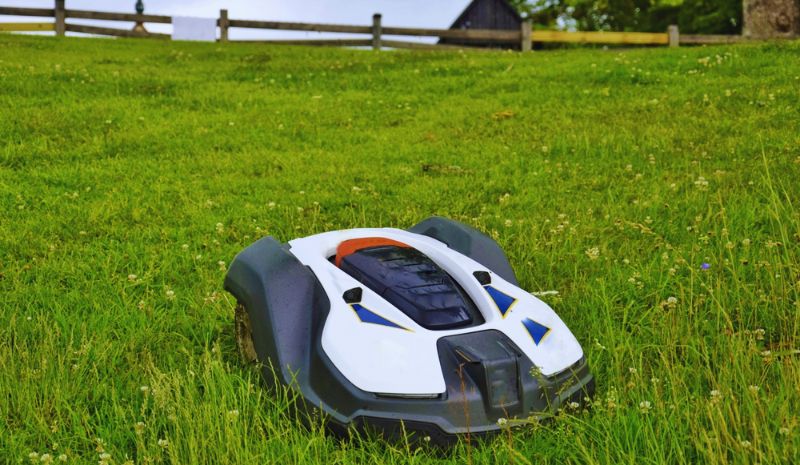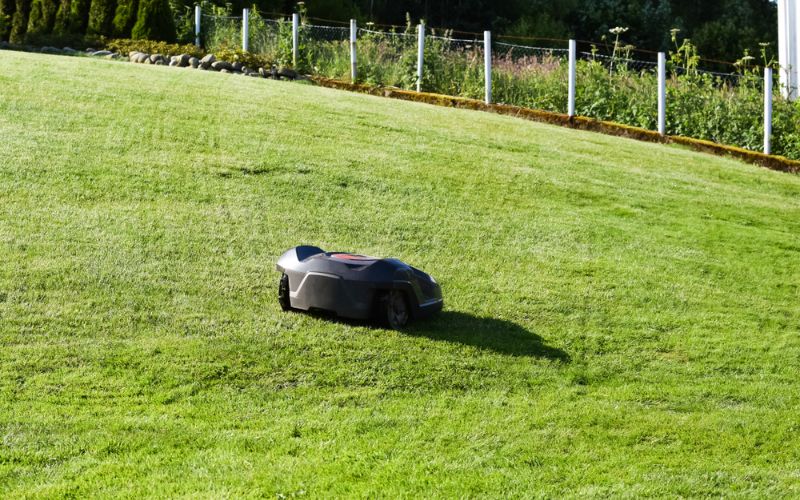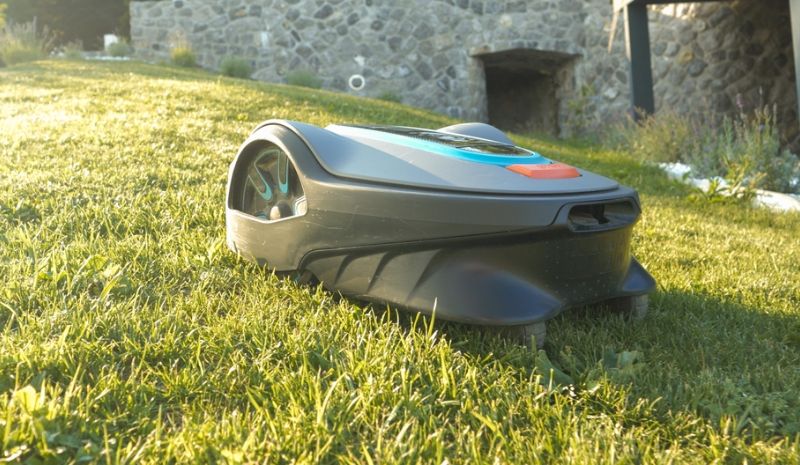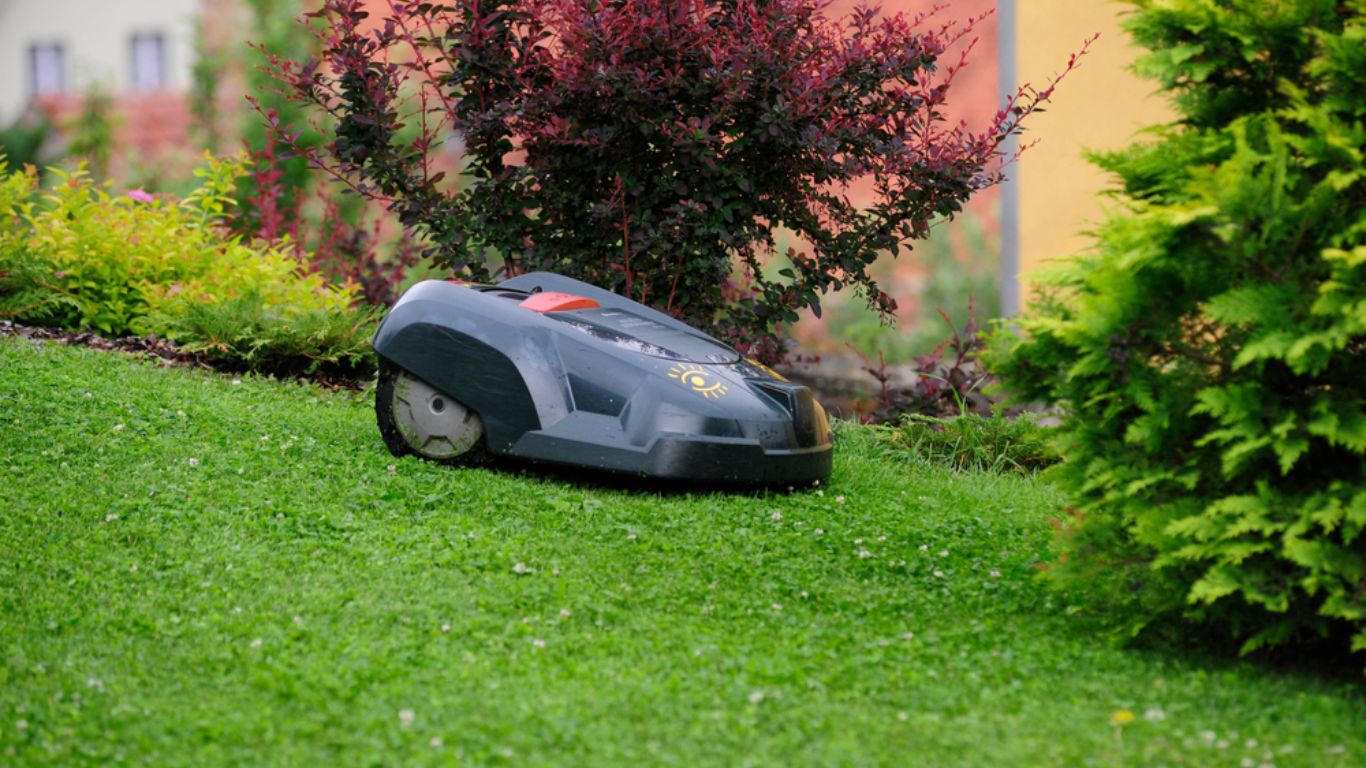At Best Lawn Mower For Hills, we frequently encounter the question: “Can robot lawn mower go uphill?” It’s a crucial concern for homeowners with sloped yards. These automated gardeners have come a long way, but their ability to handle inclines remains central to their usefulness. In this guide, we’ll delve into the technology that enables robotic mowers to tackle slopes. We’ll explore the challenges they face on hilly terrain, discuss key features that enhance their performance, and offer insights on optimizing their use in varied landscapes. Whether you’re a tech enthusiast or simply seeking a smarter way to maintain your yard, join us as we uncover the truth about robot mowers and their hill-climbing prowess.
Understanding Robot Lawn Mowers and Slopes
Defining slope capability
When assessing a robot mower’s uphill prowess, we’re dealing with percentages and degrees. Slope steepness is typically expressed as a percentage – the vertical rise over a horizontal distance. For example, a 25% grade means the terrain rises 25 feet for every 100 feet horizontally.
In the world of robotic mowing, “hilly” usually starts at about 15% grade. Entry-level models often handle up to 20%, while advanced units tackle 35% or more. For perspective, a 100% grade equals a 45-degree angle – quite the challenge for any mower!
Understanding these numbers is crucial. A robot that glides effortlessly on the flat ground might struggle on your rolling lawn, potentially leaving you with uneven results.

Challenges of mowing on inclines
Conquering slopes isn’t just about raw power. Traction is a major hurdle – steeper grades increase the risk of wheel slip, which can damage your lawn or leave patches unmowed. This is where clever wheel design and weight distribution become vital.
Battery life takes a hit on hills too. The extra energy required for climbing can significantly reduce operating time. Your tireless helper might need more frequent pit stops on undulating terrain.
Safety is another key concern. The risk of tipping increases on steeper slopes, especially during turns. While high-end models use gyroscopic sensors and smart algorithms for stability, there are still limits to what’s safe and effective.
These challenges highlight why the question of robot mowers going uphill isn’t just about possibility but practicality. The goal is a well-groomed lawn, not just a mower that can climb.

Technical Specifications for Robot Lawn Mower Go Uphill
Key features for slope performance
When it comes to conquering inclines, not all robot lawn mowers are created equal. The ability to navigate slopes depends on several crucial design elements.
First, let’s talk about wheel design and traction. The best hill-climbing mowers sport large, rugged wheels with deep treads. These provide the grip necessary to traverse slippery grass without sliding. Some models even feature all-wheel drive, distributing power evenly for enhanced stability on steep terrain.
Motor power and torque play a vital role too. Stronger motors give mowers the oomph needed to push uphill without stalling. But it’s not just about raw power – efficient torque distribution ensures the mower can maintain a steady pace on varying gradients.
Weight distribution and center of gravity are often overlooked but critically important. A low center of gravity helps prevent tipping, while even weight distribution across all wheels maximizes traction. Some advanced models adjust their weight distribution dynamically as they move, adapting to the changing slope.
Terrain sensors and adaptive technology represent the cutting edge of robotic mowing. These smart features allow mowers to detect changes in slope and adjust their cutting patterns accordingly. They might slow down on steeper sections, alter their mowing direction, or even decide to tackle a particularly tricky area in multiple passes.

Battery considerations for incline mowing
Power management becomes even more crucial when your robot lawn mower tackles hills. The increased effort required to climb slopes drains batteries faster, affecting overall performance and runtime.
High-capacity lithium-ion batteries are the go-to choice for hill-capable mowers. They provide sustained power output even under heavy loads. But it’s not just about capacity – the battery management system plays a key role in optimizing power usage across varying terrain.
Some advanced models feature adaptive power systems. These smart-systems adjust motor output based on the slope, conserving energy on flatter areas to extend runtime on hills. This intelligent power distribution ensures your mower can cover more ground before needing a recharge.
Speaking of recharging, placement of the charging station becomes critical in hilly yards. Ideally, it should be in a relatively flat area with easy access. Some mowers can even automatically adjust their docking approach based on the surrounding terrain, ensuring they can reliably return to base regardless of the path they need to take.
Battery life impact is a crucial factor to consider. A mower that promises 3 hours of runtime on flat ground might manage only half that on hilly terrain. When choosing a robot mower for a sloped yard, it’s wise to opt for models with longer-than-needed battery life to account for this increased power consumption.
Installation and Optimization Tips for Hilly Lawns
Proper setup for optimal performance
Setting up a robot lawn mower for hilly terrain requires careful planning and execution. The goal is to create an environment where your automated gardener can navigate slopes efficiently and safely.
Boundary wire placement is crucial on inclined surfaces. Unlike flat lawns, where straight lines suffice, hilly yards benefit from strategic wire positioning. Place the wire diagonally across slopes rather than straight up and down. This approach allows the mower to traverse the incline gradually, reducing strain and improving cutting consistency.
When it comes to the charging station, location is key. Opt for a relatively level spot with easy access from all areas of your yard. If possible, position it at the bottom of a slope rather than the top. This setup ensures your mower isn’t starting its journey with an uphill battle every time it leaves the dock.
Creating zones can significantly enhance your robot mower’s performance on hilly terrain. By dividing your lawn into sections based on slope severity, you can program your mower to tackle each area with tailored settings. This zoning strategy allows for more efficient battery use and improved cutting results across varied landscapes.

Maintenance for hill-climbing efficiency
Keeping your robot mower in top shape is essential for maintaining its uphill performance. Regular maintenance not only extends the life of your machine but also ensures it continues to handle slopes effectively.
Wheel cleaning and inspection should be a priority. Hills put extra stress on wheels, so check them frequently for wear and tear. Clean off any built-up grass or mud, as these can reduce traction. Some users find that aftermarket all-terrain wheels can boost performance on particularly challenging slopes.
Blade sharpness is another critical factor. Dull blades require more power to cut effectively, draining the battery faster. This power drain is especially noticeable on inclines. Sharpen or replace blades regularly to maintain cutting efficiency and reduce strain on the mower’s motor.
Don’t overlook software updates. Manufacturers often release firmware upgrades that can improve your mower’s hill-climbing algorithms. These updates might fine-tune power distribution, adjust cutting patterns for slopes, or enhance the mower’s ability to detect and navigate inclines. Staying current with these updates can significantly boost your mower’s performance on hilly terrain.
Advantages and Limitations of Robot Mowers on Hills
Benefits of using robotic mowers on slopes
Robot lawn mowers offer several compelling advantages when it comes to maintaining hilly yards. Their ability to navigate inclines autonomously can be a game-changer for homeowners with challenging landscapes.
Consistency is a standout benefit. Unlike human mowers, which might tire or rush on steep sections, robotic mowers maintain a steady pace. This results in an even cut across your entire lawn, regardless of its topography. The mower’s programmed patterns ensure no patch of grass is overlooked, even in hard-to-reach areas of your sloped yard.
Safety is another crucial advantage. Pushing a traditional mower up and down hills can be hazardous, especially on wet grass. Robot mowers eliminate this risk, tackling steep grades without putting the homeowner in harm’s way. Their low center of gravity and smart sensors help them navigate slopes safely, reducing the chance of accidents.
Time-saving automation is perhaps the most attractive feature for busy homeowners. Once properly set up, these tireless gardeners work independently, freeing you from the chore of mowing. They can operate on a schedule, ensuring your lawn stays trimmed without constant oversight. This hands-off approach is particularly valuable for large or complex hilly yards that would typically require significant time and effort to maintain.

Potential drawbacks and solutions
While robot mowers can indeed go uphill, they’re not without limitations. Understanding these challenges can help you make an informed decision and find ways to mitigate potential issues.
Extreme inclines remain a challenge for most robotic mowers. While many models can handle slopes up to 35%, steeper grades may prove problematic. In such cases, terracing or creating level paths can help. Alternatively, you might need to maintain these ultra-steep sections manually or with specialized equipment.
Increased wear and tear is another consideration. The extra strain of climbing hills can accelerate component degradation, particularly for wheels and motors. Regular maintenance becomes even more critical. Investing in models with robust build quality and easily replaceable parts can help offset this issue.
Battery life can be a limiting factor on hilly terrain. The increased power demand of uphill mowing may require more frequent charging, potentially leaving parts of your lawn unfinished in a single session. Opting for models with longer battery life or setting up multiple charging stations across your yard can address this challenge.
Navigation on complex hilly lawns can sometimes confuse robotic mowers. Sudden changes in grade or obstacles hidden by slopes might cause inefficient mowing patterns. Advanced mapping features and regular software updates can improve performance over time. In some cases, strategic placement of guide wires can help direct the mower more effectively across challenging terrain.
Future Developments in Slope-Handling Technology
Emerging technologies for improved hill performance
The landscape of robotic lawn care is evolving rapidly, with manufacturers constantly pushing the boundaries of what these machines can accomplish on inclined terrain. As we look to the future, several exciting developments promise to enhance the uphill capabilities of robot mowers.
Artificial Intelligence (AI) and machine learning algorithms are at the forefront of this innovation. These advanced systems allow mowers to learn from their environment, adapting their cutting patterns and power distribution based on the specific contours of your yard. Over time, these smart mowers become more efficient at navigating slopes, optimizing their routes for the best possible cut while conserving energy.
Sensor technology is also advancing at a breakneck pace. Next-generation mowers may incorporate LiDAR (Light Detection and Ranging) sensors, similar to those used in autonomous vehicles. These sensors create detailed 3D maps of the lawn, allowing for unprecedented precision in navigation and obstacle avoidance on uneven ground.
Terrain mapping capabilities are becoming more sophisticated. Future models might use a combination of GPS, onboard cameras, and advanced algorithms to create highly accurate topographical maps of your lawn. This detailed understanding of the landscape will enable mowers to plan the most efficient paths up and down slopes, adjusting their approach based on the steepness and condition of each section.

Predictions for next-generation robotic mowers
As we peer into the crystal ball of lawn care technology, several exciting possibilities emerge for the next wave of slope-conquering robot mowers.
Adaptive wheel systems could revolutionize how these machines tackle hills. Imagine wheels that can change their shape or tread pattern on the fly, providing optimal traction for each unique section of your lawn. This technology could allow a single mower to effortlessly transition from flat areas to steep inclines without missing a beat.
Energy harvesting might become a game-changer for battery life concerns on hilly terrain. Future mowers could incorporate small solar panels or even systems that convert the kinetic energy of downhill movement into stored electrical power. This innovation could significantly extend operating times, especially in sunny, sloped yards.
Swarm technology, where multiple smaller mowers work in tandem, could offer a novel solution for large, complex hilly lawns. These coordinated teams of mowers could divide and conquer challenging terrain, with each unit specializing in certain slope grades or lawn features.
Hybrid systems that combine autonomous operation with occasional human guidance might emerge. These mowers could handle most of the lawn independently but call for assistance via a smartphone app when encountering extremely challenging areas. This approach could offer the best of both worlds – the convenience of automation with the problem-solving capabilities of human intervention when needed.
As these technologies mature, the question “Can Robot Lawn Mower Go Uphill?” may evolve into “How efficiently can they manicure entire landscapes, regardless of terrain?” The future of robotic mowing on slopes looks bright, promising even more capable, efficient, and versatile machines for homeowners with challenging yards.
Conclusion
At Best Lawn Mower For Hills, we’ve explored the ins and outs of robotic mowers tackling slopes. The verdict? These high-tech helpers can indeed go uphill, with many models conquering grades up to 35%. While they offer consistency, safety, and convenience on hilly terrain, limitations exist for extreme inclines and complex landscapes. As technology advances, we anticipate even more capable machines emerging. Ultimately, the choice depends on your yard’s unique features. By understanding these automated gardeners’ strengths and weaknesses, you can decide if they’re the right fit for your sloped lawn. Remember, the goal is a beautifully manicured yard with minimal effort – a vision that’s becoming increasingly achievable, even on challenging terrain.
FAQs
What’s the steepest slope a robot lawn mower can handle?
Most advanced models manage up to 35% grades. Some specialized units claim to handle 45%, but performance may vary.
How does mowing uphill affect a robot mower’s battery life?
Uphill mowing demands more power, reducing battery life. Expect 30-50% less runtime on hilly terrain compared to flat lawns.
Are robot mowers safe to use on steep inclines?
Modern robot mowers are designed with safety features for slopes. However, always follow manufacturer guidelines and avoid extremely steep grades.
Can I use a robot mower if only part of my lawn is hilly?
Yes. Many models allow zone programming, adapting their approach for different areas of your yard.
How do I choose the best robot mower for my sloped yard?
Consider slope percentage, yard size, obstacle density, and battery life. Look for models with strong motors, all-wheel drive, and advanced navigation systems.


